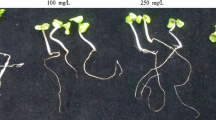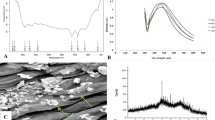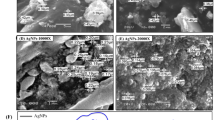Abstract
Due to the antifungal and antibacterial properties, silver nanoparticles (AgNPs) are now widely used in consumer products. In this research, the effects of various concentrations of AgNPs (0, 2.5, 5, 10, 20, 40 and 80 ppm) on growth, contents of micro- and macroelements, physiological traits and expression of PAL and GSH genes of purslane (Portulaca oleracea L.) plants were investigated. The results showed that application of AgNPs resulted in a dose-dependent enhancement in accumulation of silver (Ag) in both root and leaf tissues, however, the Ag accumulated at the root more than the leaf at all levels of the AgNPs treatment. AgNPs treatment over 20 ppm reduced the growth, biomass production and accumulation of macroelements (Ca and Mg) and microelements (Zn, Cu, Mn and B) and increased contents of H2O2, MDA and DPPH scavenging activity. Application of AgNPs also increased the activity of antioxidant enzymes such as SOD, CAT and POD enzymes compared to control treatments. The activity and expression of PAL and CHS enzymes significantly increased under treatment of AgNPs. Our results indicate that increasing the activity of antioxidant enzymes and regulating the expression and activity of PAL and CHS enzymes are mechanisms to counteract the oxidative stress induced by AgNPs in the purslane plants.






Similar content being viewed by others
REFERENCES
Navarro, E., Baun, A., Behra, R., Hartmann, N.B., Filser, J., Miao, A.J., Quigg, A., Santschi, P.H., and Sigg, L., Environmental behavior and ecotoxicity of engineered nanoparticles to algae, plants, and fungi, Ecotoxicol-ogy, 2008, vol. 17, p. 372.
Shams, G., Ranjbar, M., and Amiri, A., Effect of silver nanoparticles on concentration of silver heavy element and growth indexes in cucumber (Cucumis sativus L. Negeen), J. Nanopart. Res., 2013, vol. 15: 1630.
Sharma, P., Bhatt, D., Zaidi, M.G.H., Saradhi, P., Khanna, P.K., and Arora, S., Silver nanoparticle-mediated enhancement in growth and antioxidant status of Brassica juncea,Appl. Biochem. Biotechnol., 2012, vol. 167, p. 2225.
Nair, P.M.G. and Chung, I.M., Physiological and molecular level effects of silver nanoparticles exposure in rice (Oryza sativa L.) seedlings, Chemosphere, 2014, vol. 112, p. 105.
Jiang, H.S., Qiu, X.N., Li, G.B., Li, W., and Yin, L.Y., Silver nanoparticles induced accumulation of reactive oxygen species and alteration of antioxidant systems in the aquatic plant Spirodela polyrhiza,Environ. Toxicol. Chem., 2014, vol. 33, p. 1398.
Simopoulos, A.P., Omega-3 fatty acids and antioxidants in edible wild plants, Biol. Res., 2004, vol. 37, p. 263.
Heath, R.L. and Packer, L., Photoperoxidation in isolated chloroplasts. I. Kinetics and stoichiometry of fatty acid peroxidation, Arch. Biochem. Biophys., 1968, vol. 125, p. 189.
Velikova, V., Yordanov, I., and Edreva, A., Oxidative stress and some antioxidant systems in acid rain-treated bean plants, Plant Sci., 2000, vol. 151, p. 59.
Brand-Williams, W., Cuvelier, M.E., and Berset, C., Use of a free radical method to evaluate antioxidant activity, LWT–Food Sci. Technol., 1995, vol. 28, p. 25.
Bradford, M.M., A rapid and sensitive method for the quantitation of microgram quantities of protein utilizing the principle of protein–dye binding, Anal. Bioch-em., 1976, vol. 72, p. 248.
Bailly, C., Benamar, A., Corbineau, F., and Come, D., Changes in malondialdehyde content and in superoxide dismutase, catalase, and glutathione reductase activities in sunflower seeds as related to deterioration during accelerated ageing, Physiol. Plant., 1996, vol. 97, p. 104.
Chance, M. and Maehly, A.C., Assay of catalases and peroxidases, Methods Enzymol., 1955, vol. 2, p. 764.
Ochoa-Alejo, N. and Gómez-Peralta, J.E., Activity of enzymes involved in capsaicin biosynthesis in callus tissue and fruits of chili pepper (Capsicum annuum L.), J. Plant Physiol., 1993, vol. 41, p. 147.
Thuesombat, P., Hannongbua, S., Akasit, S., and Chadchawan, S., Effect of silver nanoparticles on rice (Oryza sativa L. cv. KDML 105) seed germination and seedling growth, Ecotoxicol. Environ. Saf., 2014, vol. 104, p. 302.
Geisler-Lee, J., Wang, Q., Yao, Y., Zhang, W., Geisler, M., Li, K., Huang, Y., Chen, Y., Kolmakov, A., and Ma, X., Phytotoxicity, accumulation and transport of silver nanoparticles by Arabidopsis thaliana, Nanotoxicology, 2013, vol. 7, p. 323.
Zuverza-Mena, N., Armendariz, R., Peralta-Videa, J.R., and Gardea-Torresdey, J.L., Effects of silver nanoparticles on radish sprouts: root growth reduction and modifications in the nutritional value, Front. Plant Sci., 2016, vol. 7: 90.
Cvjetko, P., Milošiá, A., Domijan, A.M., Vinković Vrč ek, I., Tolić , S., Peharec Štefanić , P., Letofsky-Papst, I., Tkalec, M., and Balen, B., Toxicity of silver ions and differently coated silver nanoparticles in Allium cepa roots, Ecotoxicol. Environ. Saf., 2017, vol. 137, p. 18.
Rastogi, A., Zivcak, M., Tripathi, D.K., Yadav, S., and Kalaji, H.M., Phytotoxic effect of silver nanoparticles in Triticum aestivum: improper regulation of photosystem I activity as the reason for oxidative damage in the chloroplast, Photosynthetica, 2019, vol. 57, p. 209.
Servin, A.D., Morales, M.I., Castillo-Michel, H., Hernandez-Viezcas, J.A., Munoz, B., Zhao, L., Nunez, J.E., Peralta-Videa, J.R., and Gardea-Torresdey, J.L., Synchrotron verification of TiO2 nanoparticle transfer from soil into the food chain, Environ. Sci. Technol., 2013, vol. 47, p. 11592.
Trujillo-Reyes, J., Majumdar, S., Botez, C.E., Peralta-Videa, J.R., and Gardea-Torresdey, J.L., Exposure studies of core-shell Fe/Fe3O4 and Cu/CuO NPs to lettuce (Lactuca sativa) plants: are they a potential physiological and nutritional hazard? J. Hazard. Mater., 2014, vol. 267, p. 255.
Hong, J., Rico, C.M., Zhao, L., Adeleye, A.S., Keller, A.A., Peralta-Videa, J.R., and Gardea-Torresdey, J.L., Toxic effects of copper-based nanoparticles or compounds to lettuce (Lactuca sativa) and alfalfa (Medicago sativa), Environ. Sci. Proc. Imp., 2015, vol. 17, p. 177.
Magesky, A. and Pelletier, E., Toxicity mechanisms of ionic silver and polymer-coated silver nanoparticles with interactions of functionalized carbon nanotubes on early development stages of sea urchin, Aquat. Toxicol., 2015, vol. 167, p. 106.
Zhang, H.Y., Jiang, Y.N., He, Z.Y., and Ma, M., Cadmium accumulation and oxidative burst in garlic (Allium sativum), J. Plant Physiol., 2005, vol. 162, p. 977.
Mehrian, S., Heidari, R., and Rahmani, F., Effect of silver nanoparticles on free amino acids content and antioxidant defense system of tomato plants, Indian J. Plant Physiol., 2015, vol. 20, p. 257.
Ghorbani, A., Razavi, S.M., Omran, V.O.G., and Pirdashti, H., Piriformospora indica alleviates salinity by boosting redox poise and antioxidative potential of tomato, Russ. J. Plant Physiol., 2018, vol. 65, p. 898.
Dao, T.T.H., Linthorst, H.J.M., and Verpoorte, R., Chalcone synthase and its functions in plant resistance, Phytochem. Rev., 2011, vol. 10, p. 397.
Gholizadeh, A. and Kohnehrou, B.B., Activation of phenylalanine ammonia lyase as a key component of the antioxidative system of salt-challenged maize leaves, Braz. J. Plant Physiol., 2010, vol. 22, p. 217.
Kosyk, O.I., Khomenko, I.M., Batsmanova, L.M., and Taran, N.Y., Phenylalanine ammonia-lyase activity and anthocyanin content in different varieties of lettuce under the cadmium influence, Ukr. Biochem. J., 2017, vol. 89, p. 85.
Author information
Authors and Affiliations
Corresponding author
Ethics declarations
The authors declare that they have no conflict of interest. This article does not contain any studies involving animals or human participants as objects of research.
Rights and permissions
About this article
Cite this article
Zare, Z., Pishkar, L., Iranbakhsh, A. et al. Physiological and Molecular Effects of Silver Nanoparticles Exposure on Purslane (Portulaca oleracea L.). Russ J Plant Physiol 67, 521–528 (2020). https://doi.org/10.1134/S1021443720030231
Received:
Revised:
Accepted:
Published:
Issue Date:
DOI: https://doi.org/10.1134/S1021443720030231




